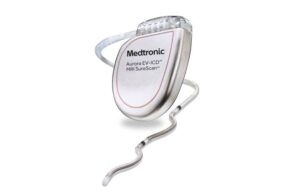
Medtronic
(NYSE: MDT)
today announced data demonstrating improved outcomes with its implantable cardioverter defibrillators (ICDs).
ICDs treat dangerously fast or irregular heart rhythms — ventricular tachycardia or ventricular fibrillation — that can lead to sudden cardiac death (SCD).
Two analyses demonstrated survival benefits nad a reduction in life-threatening cardiac events with the use of ICDs. Data provided real-world evidence supporting the use of Medtronic ICDs for indicated patients. Dr. Angelo Auricchio presented the results at the European Society of Cardiology (ESC) Congress in Amsterdam. Auricchio, the lead author of both analyses, serves as deputy head of cardiology and director of the clinical electrophysiology unit at Fondazione Cardiocentro Ticino in Lugano, Switzerland.
One retrospective analysis demonstrated an association of ICDs with 24.3% decreased risk of all-cause death. Medtronic also shared results from a real-world analysis that underscore the necessity of device replacement for long-term SCD prevention.
“ICD therapy has had a number of landmark clinical trials, dating back nearly two decades; over the years, both medical technology and optimal medical therapy have continued to evolve,” said Auricchio. These analyses show that today’s ICDs continue to positively impact patient survival – in tandem with modern heart failure medications.”
Breaking down the data from Medtronic
The retrospective analysis sought to determine the current impact of ICDs on survival. It evaluated patients who have not previously experienced a life-threatening arrhythmia (primary prevention patients).
Medtronic used de-identified, real-world, contemporary data from 2012 through 2020 for a total of 25,296 patients. Of those patients, 2,118 (8.4%) received an ICD within a year. Those patients had a 24.3% lower risk of death than patients with similar characteristics without an ICD.
The second analysis examined the incidence of ICD therapy after routine device placement in patients who didn’t receive therapy from their first ICD. It used de-identified data from 10,742 patients on the Medtronic CareLink database. Those patients received a replacement device after 2012 and through the present day.
Medtronic found 9,397 primary prevention patients and 1,345 secondary prevention patients. It evaluated time-to-first appropriate therapy after replacement through seven years post-replacement.
At seven years, the incidence of first appropriate therapy in primary prevention patients came in at 28%. Medtronic reported 17% for shock therapy and 24% for anti-tachycardia pacing (ATP) as the appropriate therapy. For secondary prevention patients, the rate came in at 24% for first appropriate therapy (14% shock, 19% ATP).
Medtronic’s positive data at ESC follows a May study that supported its ICDs. That study showed that nearly half of first-time ICD patients receive appropriate therapy for ventricular tachyarrhythmias through seven years post-implant.
“We should not assume that a primary or secondary prevention patient who didn’t receive therapy from their first ICD can go unprotected without a replacement device despite continuation of guideline-recommended pharmacological therapy,” Auricchio said. “ICDs should continue to be offered as the gold standard for life-saving intervention for all indicated patients.”